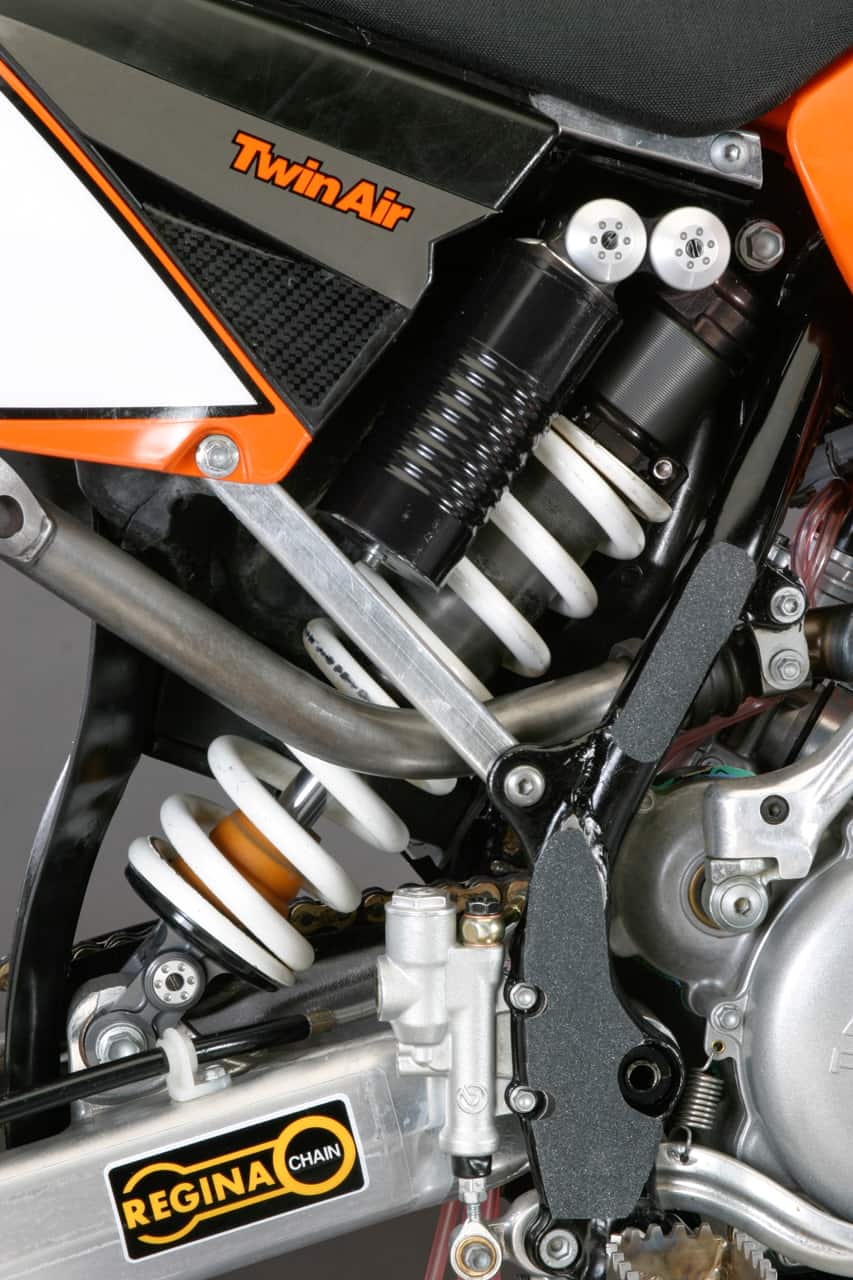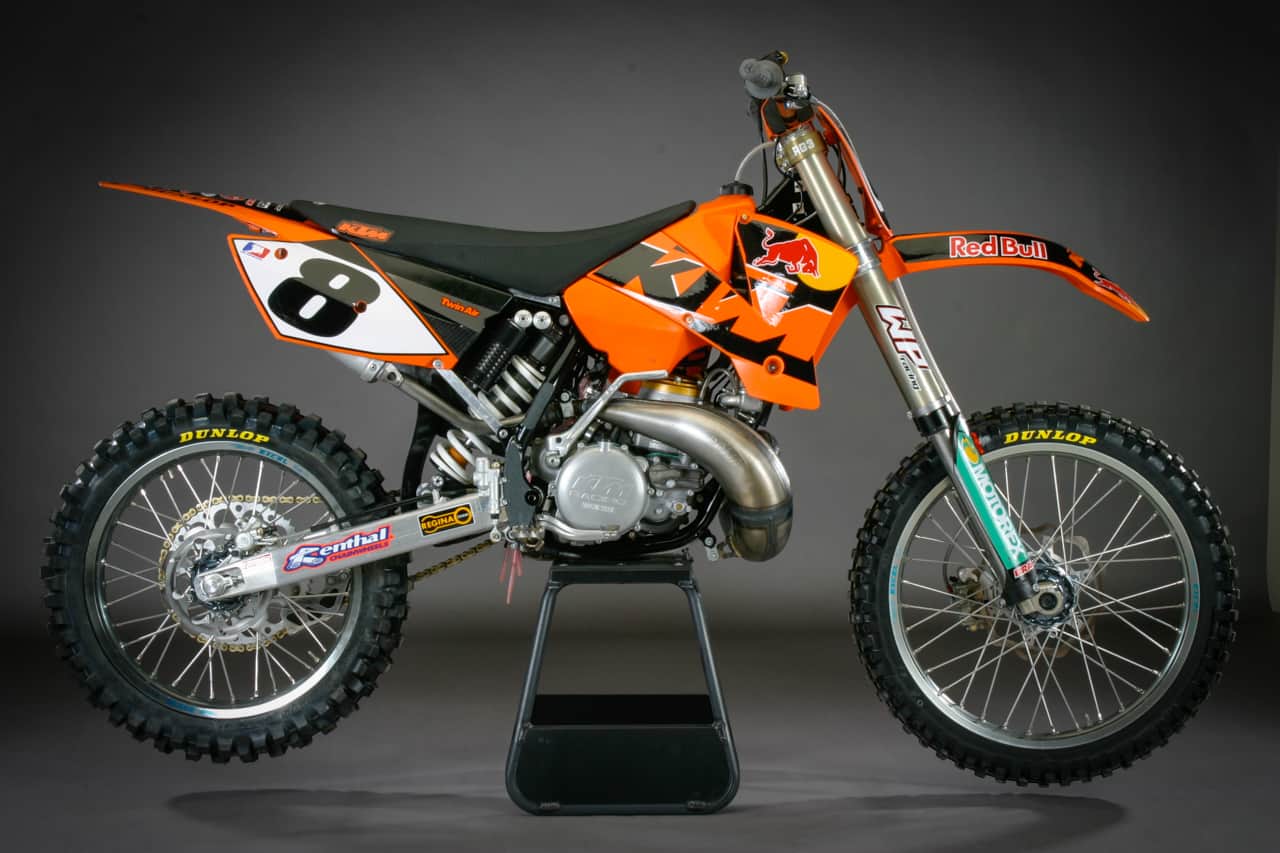ON THE RECORD: COMPLETE TEST OF GRANT LANGSTON’S 2004 KTM 250SX
 Grant Langston’s 2004 KTM 250SX.
Grant Langston’s 2004 KTM 250SX.
In the 2003 Supercross season everyone thought Grant Langston’s KTM 250SX was the cause of his short-lived introduction of 250 Supercross. There was no doubt that Grant hit the ground with alarming regularity or that his 250 Supercross debut was over before it even got started. But, the MXA wrecking crew didn’t believe that the bike was to blame anymore.
Larry Brooks (the KTM team manager at the time) hired a full-time test rider to help put time on the race bikes. Test rider Casey Lytle turned in lap after lap on the KTM 250SX while Grant was off winning the 2003 125 National crown on his much beloved KTM 125SX. Brooks, a former AMA Pro, even took up the mantle as test rider when push came to shove. With each passing week we heard reports through the pipeline that the bike was getting better and better.
HIS PERFORMANCE DIDN’T MAKE BELIEVERS OUT OF US. AT ANAHEIM 2 THINGS GOT BETTER AND GRANT ACTUALLY CRACKED THE TOP TEN. BY
SAN FRANCISCO HE MADE IT INTO THE TOP FIVE. A PODIUM LOOKED POSSIBLE AND THEN THINGS UNRAVELED
We take that kind of rumor mongering with a grain of salt. Who wouldn’t (with the possible exception of internet mavens)? Our first view of Grant Langston’s new and improved KTM 250SX would come at the opening 2004 Supercross round in Anaheim. His performance didn’t make believers out of us. At Anaheim 2 things got better and Grant actually cracked the top ten. By San Francisco he made it into the top five. A podium looked possible and then things unraveled in Houston. People started blaming the bike again and it started looking like 2003 all over again. The MXA gang had gone to every Supercross and Grant’s rash of crashes looked more like pilot error that bike induced. We’re not knocking Grant. We just don’t want the bike to get a rap it doesn’t deserve (and honestly neither does Grant). He is the first one to admit that he loves the bike. He bugs the KTM guys all the time to go riding. That was something he never did last year.
 Grant during the 2004 Supercross season.
Grant during the 2004 Supercross season.
The MXA test crew is as critical of bike performance as anyone on the earth and while gossip is the lifeblood of idle minds, the only real test of the truth would be to throw a leg over Langston’s 2004 Supercross sled for ourselves.
SOMETHING WE FOUND INTERESTING WAS THAT ONE OF GRANT’S
FOOTPEGS WERE TALLER THAN THE OTHER.
If you looked closely at Langston’s works KTM, it was a thing of beauty. Replete with all the bells and whistles that makes a bike special. The orange plastic looked amazing. The graphics wereclean. The suspension was humongous (front and rear). RG3’s four-post triple clamps housed the 52mm WP forks. The engine had an electronic power valve (and the small battery that was required to operate it). Renthal FatBar’s gave Grant the bend he wanted. Tag Metals grips were mated to the FatBar. A beryllium Brembo front brake master cylinder handled the braking duties and put the whole package over the top. KTM had definitely come a long way since Mike Fisher was their lone factory Supercross racer in 1991.
 Grant’s left leg is shorter than the other. KTM custom made a taller footpeg to compensate.
Grant’s left leg is shorter than the other. KTM custom made a taller footpeg to compensate.
Something we found interesting was that one of Grant’s footpegs were taller than the other. It turned out one of Grant’s legs is a little shorter and after a hard day’s riding Grant’s back would hurt because he was always putting more weight on one foot. The tall footpeg fixed his problems.
HOW MUCH OF THE POWERBAND’S PROWESS WAS THE RESULT OF THE COBBLED TOGETHER ELECTRONIC POWER VALVE? NOT AS MUCH AS
YOU’D THINK (AT LEAST NOT IN THE HORSEPOWER DEPARTMENT).
In the past we always had good luck testing Langston’s bikes. The first was his 2001 KTM 125SX. The second was his 125 National Championship winning 2003 KTM 125SX. To get our hands on his 2004 KTM 250SX all it took was one phone call. Larry Brooks and the KTM crew were real pleased with the work they’ve done to the 250SX and were dying to have someone outside their camp ride it. We just so happened to be those guys.
 The PDS WP shock was really stiff.
The PDS WP shock was really stiff.
Rather then send out every person involved with Langston’s bike, KTM sent a lone mechanic into our midst. That mechanic just happened to be Paul Delaurier, one the nicest guys we’ve ever meet.
While we normally have to change bar and lever positions on factory guys bikes because they had one weird quirk or another, we didn’t have to touch a thing on Langston’s bike. The bars were in the perfect spot and the levers were nice and level.
 The factory KTM 250SX engine had an electronic power valve (and the small battery that was required to operate it).
The factory KTM 250SX engine had an electronic power valve (and the small battery that was required to operate it).
Before our testers jumped aboard, Paul Delaurier had to explain the on/off switch on Grant’s bike. Almost like the key on your car you have to turn Grant’s motorcycle on before you start it. You still have to kickstart it, but before you do that you have to turn on the electronic power valve. Likewise when you stop you have to turn it off or the little battery that powers the power valve will run out of juice. Before we could do any laps the bike had to be warmed up. Not warmed up to the boiling point like Chad Reed’s works YZ250, but warmed to operating temps.
 A beryllium Brembo front brake master cylinder handled the braking duties and put the whole package over the top.
A beryllium Brembo front brake master cylinder handled the braking duties and put the whole package over the top.
Within the first lap it was very evident that the suspension was stiff. Really stiff. Both the front and rear moved, but not very much and the rear had a slight tendency to kick under deceleration. Supercross demands this type of setup so we weren’t all that surprised, although we rode Grant’s outdoor stuff enough to know that his set-up is pretty soft for a pro racer. We could have spent some time clicking both the forks and the shock, but honestly we didn’t want to stop riding.
IS THIS BIKE TO BLAME FOR GRANT’S ERRATIC PERFORMANCES IN 2003, WHICH HAVE INCLUDED LEADING MOST OF A MAIN EVENT AND
CRASHING OUT ON OCCASION? NO. GRANT HAD A STEEP
LEARNING CURVE IN HIS MOVE TO THE BIG BOY CLASS.
Why, you ask? Grant’s engine was absolutely amazing. It picked up instantly with no noticeable hit. It just started going. It continued to pull all the way through the midrange. When it finally gave up the ghost it is way up in the upper range of rev. It only took one word to describe Langston’s powerband–“linear.” You didn’t have to worry about staying on the pipe, preparing for the hit or getting on the throttle early. The engine management system was the throttle, roll it on, roll it off. It did all the work. With Grant’s engine all you had to worry about is aiming the bike.
 RG3’s four-post triple clamps housed the 52mm WP forks.
RG3’s four-post triple clamps housed the 52mm WP forks.
How much of the powerband’s prowess was the result of the cobbled together electronic power valve? Not as much as you’d think (at least not in the horsepower department). The electronic gizmo helped make the engine run the same every time. A standard power valve can snap open rapidly one second and slower the next. The electronic power valve kept the motion consistent.
With the engine helping us get into the corners faster, we needed to mention the front brake. The faster you can stop, the faster you can go. Grant’s brake was a nose wheelie implement. We respected it.
 In the past we always had good luck testing Langston’s bikes. The first was his 2001 KTM 125SX. The second was his 125 National Championship winning 2003 KTM 125SX.
In the past we always had good luck testing Langston’s bikes. The first was his 2001 KTM 125SX. The second was his 125 National Championship winning 2003 KTM 125SX.
As for the much talked about KTM handling. It wasn’t not a problem. Langston’s RG3 triple clamps had a 16mm offset, which pulled the front wheel back, shortened the front center, increased trail and put more weight on the contact patch. This was not mumbo-jumbo geometry. It was exactly what local racers have been doing for years. We didn’t suffer from the normal push that KTM’s engineers had been unable to tame, instead, the layout of Grant’s bike, including shock length, head angle, trail and fork set-up produced a very quick turning bike.
Is this bike to blame for Grant’s erratic performances in 2003, which have included leading most of a main event and crashing out on occasion? No. Grant had a steep learning curve in his move to the big boy class. But he definitely has the horsepower, handling and suspension to get the job done.





Comments are closed.